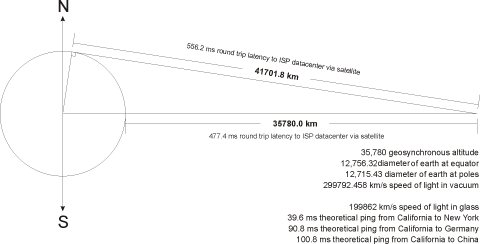Home & Office
Why Satellite Internet service is so slow
I was reading in the news today about an experimental geosynchronous communications satellite being launched by Japan and I got to wondering about why Satellite Internet service has such horrendous latency and is so slow. So I drew up a little diagram above (click to see full resolution) and did some calculations on the distance traveled and how long it takes for light to take the four-way journey.

I was reading in the news today about an experimental geosynchronous communications satellite being launched by Japan and I got to wondering about why Satellite Internet service has such horrendous latency and is so slow. So I drew up a little diagram above (click to see full resolution) and did some calculations on the distance traveled and how long it takes for light to take the four-way journey. That's because you have to go up to the satellite, then back down to the service provider, then back up to the satellite, and finally back down to you. Seeing that circle represent the planet Earth gives you some perspective how far and high a geosynchronous orbit is.
Here are some interesting numbers I compiled and estimated
- 35,780 kilometer geosynchronous altitude
- 12,756.32 kilometer diameter of earth at the equator
- 12,715.43 kilometer diameter of earth at the poles
- 299792.458 km/s is the speed of light in a vacuum
- Just the speed of light delay is between 477 ms to 556 ms delay
- With equipment delay and congestion, we're looking at 500 ms to 1000 ms delay for satellite Internet service.
- ~199862 km/s is the speed of light in glass (assuming glass is 1.5x slower than in vacuum)
- 39.6 ms theoretical ping from California to New York
- 80 ms is the realistic ping from California to New York
- 90.8 ms theoretical ping from California to Germany
- 180 ms is the realistic ping from California to Germany
- 100.8 ms theoretical ping from California to China
- 200 ms is the realistic ping from California to China
